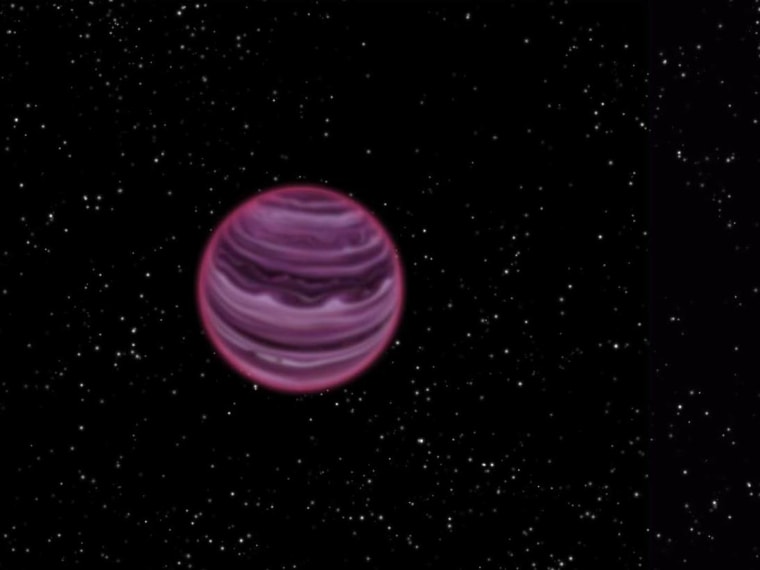Eighty light-years from Earth, there's a world that's just six times more massive than Jupiter, floating all alone without a sun to keep it warm, astronomers reported Wednesday.
Such free-floaters have been reported before, but in the past, it hasn't always been clear whether these were orphaned planets or failed stars. This time, the scientists say they're sure it's a planet.
"We have never before seen an object free-floating in space that that looks like this," team leader Michael Liu of the Institute for Astronomy at the University of Hawaii at Manoa said in a news release. "It has all the characteristics of young planets found around other stars, but it is drifting out there all alone. I had often wondered if such solitary objects exist, and now we know they do."
The heat signature of the world, known as PSO J318.5-22, was identified by the Pan-STARRS 1 wide-field survey telescope on Haleakala, on the Hawaiian island of Maui. The light coming from the object is about 100 billion times fainter in optical wavelengths than the planet Venus. Most of its energy is emitted in infrared wavelengths.
In a report being published in Astrophysical Journal Letters, Liu and his colleagues said the object has properties similar to those of gas-giant planets found orbiting young stars.
Past reports of "rogue planets" have been murky, due to the fact that it can be hard to discriminate between large planets and a class of failed stars known as brown dwarfs. Some astronomers insist on a definition of planets that would apply only to objects that form around stars. They'd prefer to call objects like PSO J318.5-22 "planetary-mass objects," or planemos for short.
PSO J318.5-22 was discovered while the researchers was combing through data from Pan-STARRS 1 for readings from brown dwarfs. Brown dwarfs are typically faint and red, but Liu and his colleagues said PSO J318.5-22 stood out because it was redder than the reddest known brown dwarfs.
They followed up with observations using the Gemini North Telescope and the NASA Infrared Telescope Facility telescopes on the summit of Hawaii's Mauna Kea, and concluded that its infrared signature was more consistent with a young planetary-mass object. The science team also monitored the object for two years using the Canada-France-Hawaii Telescope, to determine its direction of motion and its distance from Earth. That's how they figured out it was 80 light-years away.
The team concluded that PSO J318.5-22 is associated with a collection of young stars called the Beta Pictoris moving group, which formed about 12 million years ago. The best-known star in that group, Beta Pictoris, is known to harbor a gas-giant planet that's about eight times as massive as Jupiter.
Gravitational perturbations may have kicked PSO J318.5-22 out of its planetary cradle soon after it was born, or it may have been formed by a different method. Either way, Niall Deacon of the Max Planck Institute for Astronomy in Germany, a co-author of the study, said PSO J318.5-22 should help scientists get a better understanding of other planets that aren't quite as lonely.
“Planets found by direct imaging are incredibly hard to study, since they are right next to their much brighter host stars," Deacon said in the news release. "PSO J318.5-22 is not orbiting a star, so it will be much easier for us to study. It is going to provide a wonderful view into the inner workings of gas-giant planets like Jupiter shortly after their birth.”
More about free-floating planets:
- 'Orphan' planet found near Earth
- Billions of stars capture rogue planets
- Was giant planet kicked out of our solar system?
In addition to Liu and Deacon, authors of "The Extremely Red, Young L Dwarf PSO J318-22: A Free-Floating Planetary-Mass Analog to Directly Imaged Young Gas-Giant Planets" include Eugene Magnier, Katelyn Allers, Trent Dupuy, Michael Kotson, Kimberly Aller, W.S. Burgett, K.C. Chambers, P.W. Draper, K.W. Hodapp, R. Jedicke, R.-P. Kudritzki, N. Metcalfe, J.S. Morgan, N. Kaiser, P.A. Price, J.L. Tonry and R.J. Wainscoat.
Alan Boyle is NBCNews.com's science editor. Connect with the Cosmic Log community by "liking" the NBC News Science Facebook page, following @b0yle on Twitter and adding +Alan Boyle to your Google+ circles. To keep up with NBCNews.com's stories about science and space, sign up for the Tech & Science newsletter, delivered to your email in-box every weekday. You can also check out "The Case for Pluto," my book about the controversial dwarf planet and the search for new worlds.
